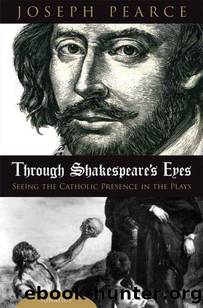Through Shakespeare's Eyes by Pearce Joseph

Author:Pearce, Joseph [Pearce, Joseph]
Language: eng
Format: epub
Tags: Spiritual & Religion
ISBN: 9781586174132
Publisher: Ignatius Press
Published: 2010-01-18T05:00:00+00:00
14
HAMLET AND THE GHOST
Let us begin with Hamlet himself. It has been suggested by many critics that Shakespeare may have sought to âpoliticizeâ the drama with his own semiconcealed sympathy for the Earl of Essex, who is believed to have been the model for the character of Hamlet.1 In 1598, the year in which Hamlet was written and first performed, the Earl of Essex had quarreled with the queen and had complained bitterly of his treatment at Elizabethâs hands: âWhen the vilest of all indignities are done unto me, doth religion enforce me to sue? or doth God require it? Is it impiety not to do it? What, cannot princes err? cannot subjects receive wrong? Is an earthly power or authority infinite?â2 In the following year, Essex concluded an armistice with the Irish rebel leader Tyrone that promised that Catholic worship in Ireland would be tolerated. The armistice served to further alienate Essex from the queenâs favor, and when he returned to England he was placed under house arrest.
Shakespeareâs admiration for Essex is not really in question, and it has been suggested that allusions to Essex appear in The Merchant of Venice, King John, Troilus and Cressida, Henry V, and Shakespeareâs cryptic poem âThe Phoenix and the Turtleâ. It is also significant that Sir Charles Percy and a number of other supporters of Essex arranged for Shakespeareâs company to stage a performance of Richard II on the eve of the Essex rebellion in the hope that the playâs depiction of the deposing of a monarch would incite the people of London to rise up against Elizabeth. It is, however, as the model for Hamlet that the Earl of Essex is most obviously present in the Bardâs work, and it will be necessary to discuss this connection, and its implications, more closely if we are to get to grips with this most difficult of Shakespeareâs plays. As we look at the playâs metadrama, we will see the ghostly presence of Essex looming over the action as palpably as the presence of the Ghost itself.
Although Essex was himself a Protestant, he promised toleration of Catholicism if his planned rebellion succeeded in deposing the queen. When, at the beginning of 1601, the rebellion failed, Essex was executed, and the Earl of Southampton, Shakespeareâs patron and one of Essexâ closest allies, was imprisoned in the Tower of London. At his trial, Essex was accused of being a papist, or papist sympathizer, but he went to his death protesting that he remained a Protestant. Essex can therefore be seen as a representative of all those subjects of the queen who found themselves alienated from her because of her persecution of them on grounds of politics or religion. Shakespeareâs own father had been fined for his recusancy,3 as had many of Shakespeareâs closest friends, and his patron, Southampton, was a well-known Catholic with many connections to the Catholic underground. To speak openly of oneâs disapproval of the queen was dangerous, possibly deadly, and one can see
Download
This site does not store any files on its server. We only index and link to content provided by other sites. Please contact the content providers to delete copyright contents if any and email us, we'll remove relevant links or contents immediately.
Harry Potter and the Goblet Of Fire by J.K. Rowling(3023)
Unfinished: A Memoir by Priyanka Chopra Jonas(2911)
Never by Ken Follett(2869)
The Man Who Died Twice by Richard Osman(2289)
Machine Learning at Scale with H2O by Gregory Keys | David Whiting(2263)
Fairy Tale by Stephen King(2058)
Will by Will Smith(2032)
Rationality by Steven Pinker(1759)
The Storyteller by Dave Grohl(1655)
The Dawn of Everything: A New History of Humanity by David Graeber & David Wengrow(1564)
The Dark Hours by Michael Connelly(1562)
The Stranger in the Lifeboat by Mitch Albom(1527)
Cloud Cuckoo Land by Anthony Doerr(1428)
The Becoming by Nora Roberts(1323)
Friends, Lovers, and the Big Terrible Thing by Matthew Perry(1320)
Crying in H Mart by Michelle Zauner(1312)
Einstein: His Life and Universe by Walter Isaacson(1311)
New Morning Mercies: A Daily Gospel Devotional by Paul David Tripp(1299)
A Short History of War by Jeremy Black(1295)
